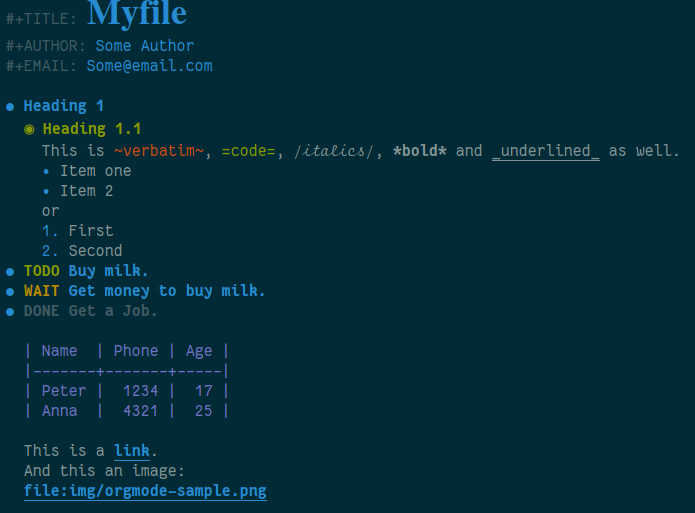Org-mode is an Emacs mode for note taking, project planing and making TODO lists (because we all need TODO lists to GTD). It can handle more things: Calendar, diary, agenda and export you Org documents to other file extensions. I am not going do talk about all can do with org-mode, you can google yourself for further information. I am going to focus in note taking and export.
The org file
It all starts with a file with a .org extension. Create one in Doomemacs with SPC . and name it "myfile.org". By default a template should fill the title like:
#+TITLE: MyfileThis is part of the heading of the document. Here you can specify some options like the author, email, date or disable the table of contents (toc).
#+AUTHOR: Some Author
#+EMAIL: Some@email.com
#+OPTIONS: toc:nilAfter this, the body of the document begins. You start a headline with * and two of them ** indicate a subheadline. You can specify verbatim text between ~|~, code inside =|=, italics surrounded by /|/ and bold text inside *|*. (The | indicates the cursor position, or where you write your text).
* Heading 1
** Heading 1.1
This is ~verbatim~, =code=, /italics/, *bold* and _underlined_ as well.Lists and TODO's
For simple bullet list you can start it with:
- Item one
- Item 2or numbered list
1. First.
2. Second.The cool thing, is that pressing Alt-RET (alt-enter) will automatically take you to the next line keeping the counting of the items (e.g. If you are in item "2. Second" and press Alt-RET the next item will be "3. |").
To insert a TODO just type: "* Buy milk" and then press SPC m t t to mark it as a TODO. Or press Shift-Right/Left to change the state from "TODO" to "DONE"
* TODO Buy milk.
* WAIT Get money to but milk.
* DONE Get a Job.Blocks, comments & quotes
To start a block just write (ignore the "." at the beginning):
.#+BEGIN_SRC NameOfTheLanguageCode
.#+END_SRCQuotes and comments are similar
#+begin_quote
#+end_quote
#+BEGIN_COMMENT
#+END_COMMENTTables, figures & links
Yes, we can have tables. Use "|" and type "name", again "|", type "Phone" and press TAB. You will see how Emacs starts to arrange the table fitting automatically the width according to the content.
| Name | Phone | Age |
|-------+-------+-----|
| Peter | 1234 | 17 |
| Anna | 4321 | 25 |Inserting a figure is simple as typing: [[/path/to/the/image][desciption]]. If you press zi in DoomEmacs it will call the function org-toggle-inline-images and will display the image you set in the document.
The same syntax is used for the links, just type: [[url][desciption]]
In DoomEmacs you can press SPC m l l to insert links and files/images.
Final thoughts
The great thing about org-mode is that you can fold/unfold the sections of the document, to navigate quickly trough the notes, and export this plain text document (Yes, if you open the org file in a notepad you will see just plain text, is Emacs that renders the plain text) to a more common document types such as:
- Org document –> LaTeX document -> PDF document.
- Org document –> ODT document (the free alternative to Microsoft doc files, look at LibreOffice project).
- Org document –> Markdown document (another plain text format).
- Org document –> html document.
- Org document –> Plain text document.
You can export from one to another document with Pandoc, which was meant to convert from Markdown to any type of document. As the Pandoc's page says:
If you need to convert files from one markup format into another, pandoc is your swiss-army knife. Pandoc can convert between the following formats.
And there are several formats. However, for simple day-life PDF, html, ODT and plain text (for emails) the Emacs org-export works fine.
As an example, an org document can look like this
If you found this content useful, please support me:
BTC: 1E2YjL6ysiPxRF4AEdXChpzpesRuyzgE1y